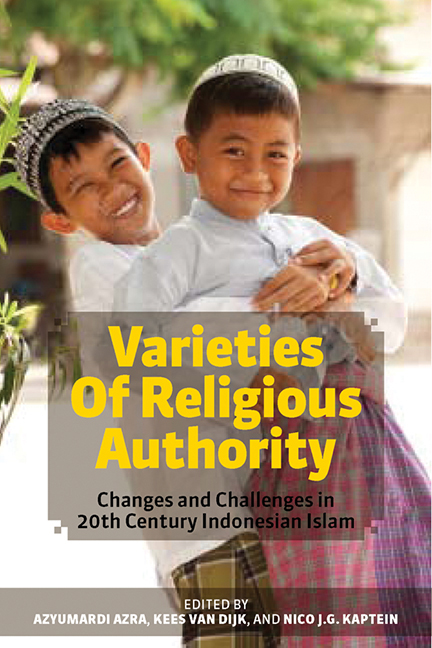Book contents
- Frontmatter
- Contents
- About the Contributors
- Acknowledgements
- Introduction
- 1 The Redefinition of Religious Authority among South Asian Muslims from 1919 to 1956
- 2 Understanding Al-Imam's Critique of Tariqa Sufism
- 3 Traditional Islam and Modernity: Some Notes on the Changing Role of the Ulama in Early Twentieth Indonesia
- 4 The Role and Identity of Religious Authorities in the Nation State: Egypt, Indonesia, and South Africa Compared
- 5 Authority Contested: Mathla'ul Anwar in the Last Years of the New Order
- 6 Struggle for Authority: Between Formal Religious Institution and Informal-local Leaders
- 7 The Indonesian Madrasah: Islamic Reform and Modernization of Indonesian Islam in the Twentieth Century
- 8 From Apolitical Quietism to Jihadist Activism: “Salafis”, Political Mobilization, and Drama of Jihad in Indonesia
- 9 From handling Water in a Glass to Coping with an Ocean: Shifts in Religious Authority in Indonesia
- 10 Religious Authority and the Supernatural
- Index
Introduction
Published online by Cambridge University Press: 21 October 2015
- Frontmatter
- Contents
- About the Contributors
- Acknowledgements
- Introduction
- 1 The Redefinition of Religious Authority among South Asian Muslims from 1919 to 1956
- 2 Understanding Al-Imam's Critique of Tariqa Sufism
- 3 Traditional Islam and Modernity: Some Notes on the Changing Role of the Ulama in Early Twentieth Indonesia
- 4 The Role and Identity of Religious Authorities in the Nation State: Egypt, Indonesia, and South Africa Compared
- 5 Authority Contested: Mathla'ul Anwar in the Last Years of the New Order
- 6 Struggle for Authority: Between Formal Religious Institution and Informal-local Leaders
- 7 The Indonesian Madrasah: Islamic Reform and Modernization of Indonesian Islam in the Twentieth Century
- 8 From Apolitical Quietism to Jihadist Activism: “Salafis”, Political Mobilization, and Drama of Jihad in Indonesia
- 9 From handling Water in a Glass to Coping with an Ocean: Shifts in Religious Authority in Indonesia
- 10 Religious Authority and the Supernatural
- Index
Summary
The twentieth century was a period of profound political, social and religious changes in Indonesia. From a Dutch colony, Indonesia, the country with the largest number of Muslims in the world, was transformed into an independent, semi-secular state, in which “Belief in the One and Only God” (and not Islam) became one of the constitutional “Pancasila” pillars of political and social life. In the first decades of the last century, Islamic leaders and Islamic organizations had to operate in a setting in which the establishment of direct colonial rule was accompanied by strong competition between the state and Muslim authorities. Thereafter, political circumstances changed dramatically. From 1942 to 1945 Indonesia was ruled by Japan, while between 1945 and 1950 the War for Independence was fought and won. After 1950 Muslim religious and political leaders had to take into account different forms of government, each with its own specific ideas about the place of Islam in society; first a democracy modelled along Western lines; then, after 1959 a period of some forty years in which Indonesia was ruled by two successive totalitarian regimes and freedom of expression was curtailed; finally, the present-day situation in which, in reaction to what the country had experienced in the decades before Soeharto had to step down as President in 1998, civic liberties are stressed.
The economy also changed over time, resulting in transformations which posed new challenges to existing religious values and patterns of association. People were drawn into larger social, cultural and economic structures. The Indonesian economy developed from one which was rural- based and geared to the interests of the colonial power, first those of the Netherlands and than those of Japan, to one in which national interests and development became important catchwords. Initially the effort seemed to fail. In the 1960s the Indonesian economy went through extremely bad times. The year 1969 saw the start of the first of a series of Five-Year Development Plans.
- Type
- Chapter
- Information
- Varieties of Religious AuthorityChanges and Challenges in 20th Century Indonesian Islam, pp. xiii - xviiiPublisher: ISEAS–Yusof Ishak InstitutePrint publication year: 2010

